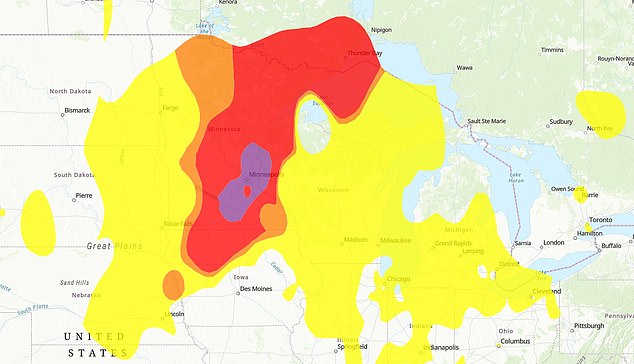
Toxic Chemical Crisis Sparks Emergency Air Alert, Forcing Shelter-In-Place Order in Major US City
Air Quality Emergency in Minnesota as Canadian Wildfire Smoke Spreads
Minnesota has declared an air quality emergency as toxic smoke from Canadian wildfires blankets Minneapolis and its suburbs, posing severe health risks. Over 160 active wildfires in British Columbia, Saskatchewan, and Manitoba have pushed hazardous air into the northern U.S., prompting alerts for 3.6 million Americans.
Blaine, a Minneapolis suburb, currently has the worst air quality in the U.S., with an Air Quality Index (AQI) of 253—deep in the “Very Unhealthy” range. Saint Paul (234), Minneapolis (210), and Savage (204) follow closely (see image below). The AQI scale considers 50 or below “good”; prolonged exposure to levels above 200 may harm even healthy individuals.

Minneapolis and its suburbs face "Very Unhealthy" air due to Canadian wildfire smoke. Blaine (AQI 253) and Saint Paul (AQI 234) are among the worst-hit areas.
Health Warnings and Impact
Officials warn that vulnerable groups—pregnant women, children, the elderly, and those with respiratory conditions—should limit outdoor activities. All of Minnesota remains under alerts until Wednesday, though conditions may improve to “Unhealthy for Sensitive Groups” (AQI 100s) by afternoon. Clearer skies are expected by Thursday.
The smoke has also drifted into Wisconsin, Iowa, and Nebraska. Eastern Iowa, including Burlington and Maquoketa, reports “Unhealthy” levels (AQI 151–200), while northern Iowa hovers in “Moderate” ranges. In Nebraska, Blair and Blakely Township residents are advised to take precautions.

Saint Paul’s AQI reached 234 as wildfire smoke engulfed the region. Health risks remain high for sensitive populations.
Wildfires and Evacuations in Canada
Canada faces its own crisis, with Manitoba declaring a state of emergency and evacuating 17,000 residents—the largest evacuation in decades. Over 100 fires burn in Manitoba alone, surpassing the annual average. Alberta’s wildfires near Chipewyan Lake have disrupted oil production and forced evacuations.
Historical Context
Canada’s 2023 wildfire season was its worst on record, charring 45 million acres and blanketing U.S. cities from the Northeast to the Great Lakes in dangerous smog. New York City urged residents indoors last year as skies turned orange, and alerts spanned 18 states.
Hope for Relief
Meteorologists predict thunderstorms will push smoke eastward, easing Midwest haze later this week. Brooke Hagenhoff of the National Weather Service noted, “Improvement is expected as the weather system shifts.”
While the current crisis mirrors past events, officials stress vigilance. Reduced outdoor exposure, N95 masks, and air purifiers remain critical until skies clear.
Featured image: 2023 Canadian wildfire smoke engulfing U.S. cities (Credit: Daily Mail)

Canada’s record 2023 wildfires caused hazardous air quality across the U.S., foreshadowing this year’s recurring threat.
Residents are urged to monitor updates and prioritize health until air quality improves.
(Word count: ~600)


